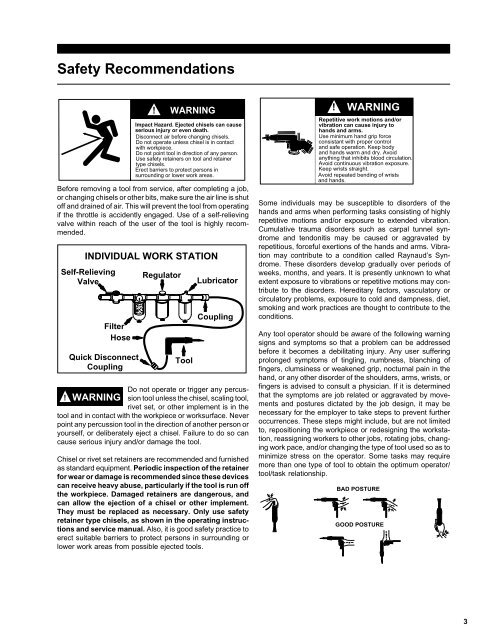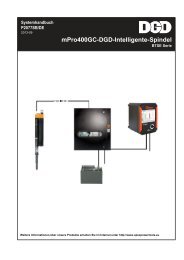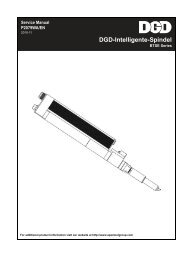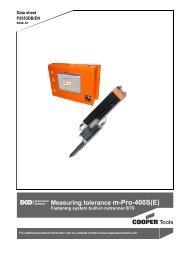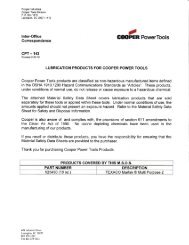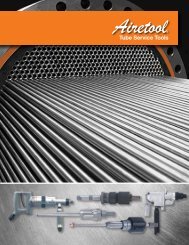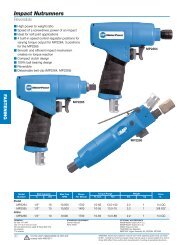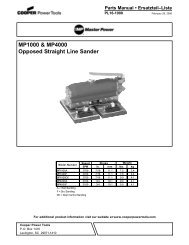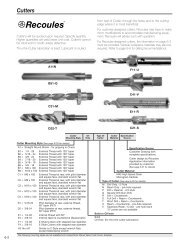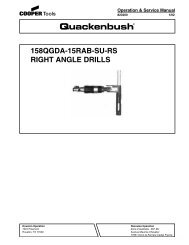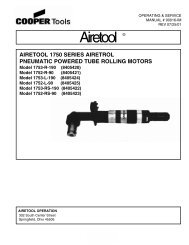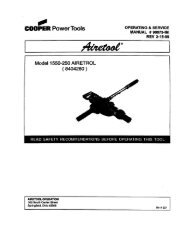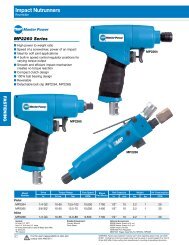Create successful ePaper yourself
Turn your PDF publications into a flip-book with our unique Google optimized e-Paper software.
Safety Recommendations<br />
Before removing a tool from service, after completing a job,<br />
or changing chisels or other bits, make sure the air line is shut<br />
off and drained of air. This will prevent the tool from operating<br />
if the throttle is accidently engaged. Use of a self-relieving<br />
valve within reach of the user of the tool is highly recommended.<br />
INDIVIDUAL WORK STATION<br />
Self-Relieving<br />
Valve<br />
Filter<br />
Hose<br />
Quick Disconnect<br />
Coupling<br />
0<br />
90<br />
45<br />
!<br />
Impact Hazard. Ejected chisels can cause<br />
serious injury or even death.<br />
Disconnect air before changing chisels.<br />
Do not operate unless chisel is in contact<br />
with workpiece.<br />
Do not point tool in direction of any person.<br />
Use safety retainers on tool and retainer<br />
type chisels.<br />
Regulator<br />
WARNING<br />
Erect barriers to protect persons in<br />
surrounding or lower work areas.<br />
<strong>Tool</strong><br />
Lubricator<br />
Coupling<br />
Do not operate or trigger any percus-<br />
!<br />
WARNING sion tool unless the chisel, scaling tool,<br />
rivet set, or other implement is in the<br />
tool and in contact with the workpiece or worksurface. Never<br />
point any percussion tool in the direction of another person or<br />
yourself, or deliberately eject a chisel. Failure to do so can<br />
cause serious injury and/or damage the tool.<br />
Chisel or rivet set retainers are recommended and furnished<br />
as standard equipment. Periodic inspection of the retainer<br />
for wear or damage is recommended since these devices<br />
can receive heavy abuse, particularly if the tool is run off<br />
the workpiece. Damaged retainers are dangerous, and<br />
can allow the ejection of a chisel or other implement.<br />
They must be replaced as necessary. Only use safety<br />
retainer type chisels, as shown in the operating instructions<br />
and service manual. Also, it is good safety practice to<br />
erect suitable barriers to protect persons in surrounding or<br />
lower work areas from possible ejected tools.<br />
!<br />
WARNING<br />
Repetitive work motions and/or<br />
vibration can cause injury to<br />
hands and arms.<br />
Use minimum hand grip force<br />
consistant with proper control<br />
and safe operation. Keep body<br />
and hands warm and dry. Avoid<br />
anything that inhibits blood circulation.<br />
Avoid continuous vibration exposure.<br />
Keep wrists straight.<br />
Avoid repeated bending of wrists<br />
and hands.<br />
Some individuals may be susceptible to disorders of the<br />
hands and arms when performing tasks consisting of highly<br />
repetitive motions and/or exposure to extended vibration.<br />
Cumulative trauma disorders such as carpal tunnel syndrome<br />
and tendonitis may be caused or aggravated by<br />
repetitious, forceful exertions of the hands and arms. Vibration<br />
may contribute to a condition called Raynaud’s Syndrome.<br />
These disorders develop gradually over periods of<br />
weeks, months, and years. It is presently unknown to what<br />
extent exposure to vibrations or repetitive motions may contribute<br />
to the disorders. Hereditary factors, vasculatory or<br />
circulatory problems, exposure to cold and dampness, diet,<br />
smoking and work practices are thought to contribute to the<br />
conditions.<br />
Any tool operator should be aware of the following <strong>warning</strong><br />
signs and symptoms so that a problem can be addressed<br />
before it becomes a debilitating injury. Any user suffering<br />
prolonged symptoms of tingling, numbness, blanching of<br />
fingers, clumsiness or weakened grip, nocturnal pain in the<br />
hand, or any other disorder of the shoulders, arms, wrists, or<br />
fingers is advised to consult a physician. If it is determined<br />
that the symptoms are job related or aggravated by movements<br />
and postures dictated by the job design, it may be<br />
necessary for the employer to take steps to prevent further<br />
occurrences. These steps might include, but are not limited<br />
to, repositioning the workpiece or redesigning the workstation,<br />
reassigning workers to other jobs, rotating jobs, changing<br />
work pace, and/or changing the type of tool used so as to<br />
minimize stress on the operator. Some tasks may require<br />
more than one type of tool to obtain the optimum operator/<br />
tool/task relationship.<br />
BAD POSTURE<br />
GOOD POSTURE<br />
3


